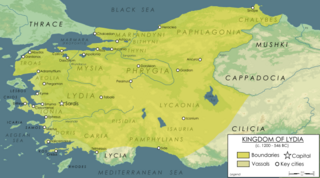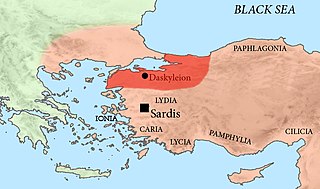
Alyattes, sometimes described as Alyattes I, was the fourth king of the Mermnad dynasty in Lydia, the son of Sadyattes, grandson of Ardys, and great-grandson of Gyges. He died after a reign of 57 years and was succeeded by his son Croesus.

Lydia was an Iron Age kingdom situated in the west of Asia Minor, in modern-day Turkey. Later, it became an important province of the Achaemenid Empire and then the Roman Empire. Its capital was Sardis.

Sardis or Sardes was an ancient city best known as the capital of the Lydian Empire. After the fall of the Lydian Empire, it became the capital of the Persian satrapy of Lydia and later a major center of Hellenistic and Byzantine culture. Now an active archaeological site, it is located in modern day Turkey, in Manisa Province, near the town of Sart.

Croesus was the king of Lydia, who reigned from 585 BC until his defeat by the Persian king Cyrus the Great in 547 or 546 BC. According to Herodotus, he reigned 14 years. Croesus was renowned for his wealth; Herodotus and Pausanias noted that his gifts were preserved at Delphi. The fall of Croesus had a profound effect on the Greeks, providing a fixed point in their calendar. "By the fifth century at least", J. A. S. Evans has remarked, "Croesus had become a figure of myth, who stood outside the conventional restraints of chronology."

The Ionian Revolt, and associated revolts in Aeolis, Doris, Cyprus and Caria, were military rebellions by several Greek regions of Asia Minor against Persian rule, lasting from 499 BC to 493 BC. At the heart of the rebellion was the dissatisfaction of the Greek cities of Asia Minor with the tyrants appointed by Persia to rule them, along with the individual actions of two Milesian tyrants, Histiaeus and Aristagoras. The cities of Ionia had been conquered by Persia around 540 BC, and thereafter were ruled by native tyrants, nominated by the Persian satrap in Sardis. In 499 BC, the tyrant of Miletus, Aristagoras, launched a joint expedition with the Persian satrap Artaphernes to conquer Naxos, in an attempt to bolster his position. The mission was a debacle, and sensing his imminent removal as tyrant, Aristagoras chose to incite the whole of Ionia into rebellion against the Persian king Darius the Great.

The Greco-Persian Wars were a series of conflicts between the Achaemenid Empire and Greek city-states that started in 499 BC and lasted until 449 BC. The collision between the fractious political world of the Greeks and the enormous empire of the Persians began when Cyrus the Great conquered the Greek-inhabited region of Ionia in 547 BC. Struggling to control the independent-minded cities of Ionia, the Persians appointed tyrants to rule each of them. This would prove to be the source of much trouble for the Greeks and Persians alike.

The Battle of Lade was a naval battle which occurred during the Ionian Revolt, in 494 BC. It was fought between an alliance of the Ionian cities and the Persian Empire of Darius the Great, and resulted in a decisive victory for the Persians which all but ended the revolt.
Artaphernes, was influential circa 513–492 BC and was a brother of the Achaemenid king of Persia, Darius I. He was appointed satrap of Lydia from the capital of Sardis, and was a Persian general. In his position he had numerous contacts with the Greeks, and played an important role in both the Siege of Naxos and in suppressing the Ionian Revolt.

The Battle of Thymbra was the decisive battle in the war between Croesus of the Lydian Kingdom and Cyrus the Great of the Achaemenid Empire. Cyrus, after he had pursued Croesus into Lydia after the drawn Battle of Pteria, met the remains of Croesus' partially-disbanded army in battle on the plain north of Sardis in December 547 BC. Croesus' army was about twice as large and had been reinforced with many new men, but Cyrus still utterly defeated it. That proved to be decisive, and after the 14-day Siege of Sardis, the city and possibly its king fell, and Lydia was conquered by the Persians.
The Battle of Pteria was fought in 547 BC between the Persian forces of Cyrus the Great and the Lydian forces of Croesus. Both armies suffered heavy casualties in this indecisive battle.
Harpagus, also known as Harpagos, was a Median general during the 6th century BC, credited by Herodotus as having put Cyrus the Great on the throne through his defection during the Battle of Pasargadae.
Mazares was a Median general who defected to Cyrus the Great when the latter overthrew the Median king Astyages and formed the Persian Empire. Mazares is mentioned by Herodotus as a Median general in the service of Cyrus the Great who died while putting down a revolt in Asia Minor.

The siege of Naxos was a failed attempt by the Milesian tyrant Aristagoras, operating with support from, and in the name of the Persian Empire of Darius the Great, to conquer the island of Naxos. It was the opening act of the Greco-Persian Wars, which would ultimately last for 50 years.

Cyme or Cumae was an Aeolian city in Aeolis close to the kingdom of Lydia. It was called Phriconian, perhaps from the mountain Phricion in Aeolis, near which the Aeolians had been settled before their migration to Asia.

The Satrapy of Lydia, known as Sparda in Old Persian, was an administrative province (satrapy) of the Achaemenid Empire, located in the ancient kingdom of Lydia, with Sardis as its capital.

Der hochmütige, gestürzte und wieder erhabene Croesus is a three-act opera composed by Reinhard Keiser. The German language libretto by Lucas von Bostel was based on Nicolò Minato's 1678 dramma per musica Creso, the music for which was composed by the Emperor Leopold I.

The siege of Sardis was the last decisive conflict after the Battle of Thymbra, which was fought between the forces of Croesus of Lydia and Cyrus the Great, when Cyrus followed Croesus to his city, laid siege to it for 14 days and captured it.

Pactyes was the Lydian put in charge of civil administration and gathering Croesus's gold when Lydia was conquered by Cyrus the Great of Persia around 546 BC:
Presently, entrusting Sardis to a Persian called Tabalus, and charging Pactyes, a Lydian, to take charge of the gold of Croesus and the Lydians, he himself marched away to Ecbatana, taking with him Croesus, and at first making no account of the Ionians. For he had Babylon on his hands and the Bactrian nation and the Sacae and Egyptians; he was minded to lead an army himself against these and to send another commander against the Ionians.

Bagaeus, son of Artontes, was an Achaemenid nobleman, who was ordered by Darius I to kill the rebellious satrap of Lydia, Oroetes. Oroetes was accused of having killed Mitrobates, the satrap of Daskyleion and his son, but is best known as the murderer of Polycrates of Samos. Herodotus recounts how Bagaeus used written orders from Darius in order to assure himself of the obedience of the bodyguards of Oroetes to the orders of Darius, and when assured, produced a final order to kill Oroetes:
So when Darius became king, he wanted to punish Oroetes for all his wrongdoing, and especially for killing Mitrobates and his son. But he thought it best not to send an army openly against the satrap, seeing that everything was still in confusion and he was still new to the royal power; moreover he heard that Oroetes was very powerful, having a guard of a thousand Persian spearmen and being governor of the Phrygian and Lydian and Ionian province. He had recourse, then, to the following expedient: having summoned an assembly of the most prominent Persians, he addressed them as follows: “Persians, which of you will promise to do this for me, not with force and numbers, but by cunning? Where there is need for cunning, force has no business. So then, which of you would either bring me Oroetes alive or kill him? For he has done the Persians no good, but much harm; he has destroyed two of us, Mitrobates and his son, and is killing my messengers that are sent to recall him, displaying an insolence that is not to be borne. So, then, before he does the Persians some still greater harm, he has to be punished by us with death.” Darius asked this and thirty men promised, each wanting to do it himself. Darius told them not argue but draw lots; they did, and the lot fell to Bagaeus, son of Artontes. Bagaeus, having drawn the lot, did as follows: he had many letters written concerning many things and put the seal of Darius on them, and then went with them to Sardis.

Oebares II was, according to Herodotus a son of Megabazus, himself a first degree cousin of Darius I. Oebares became satrap of Daskyleion in 493 BC, after his father.


















